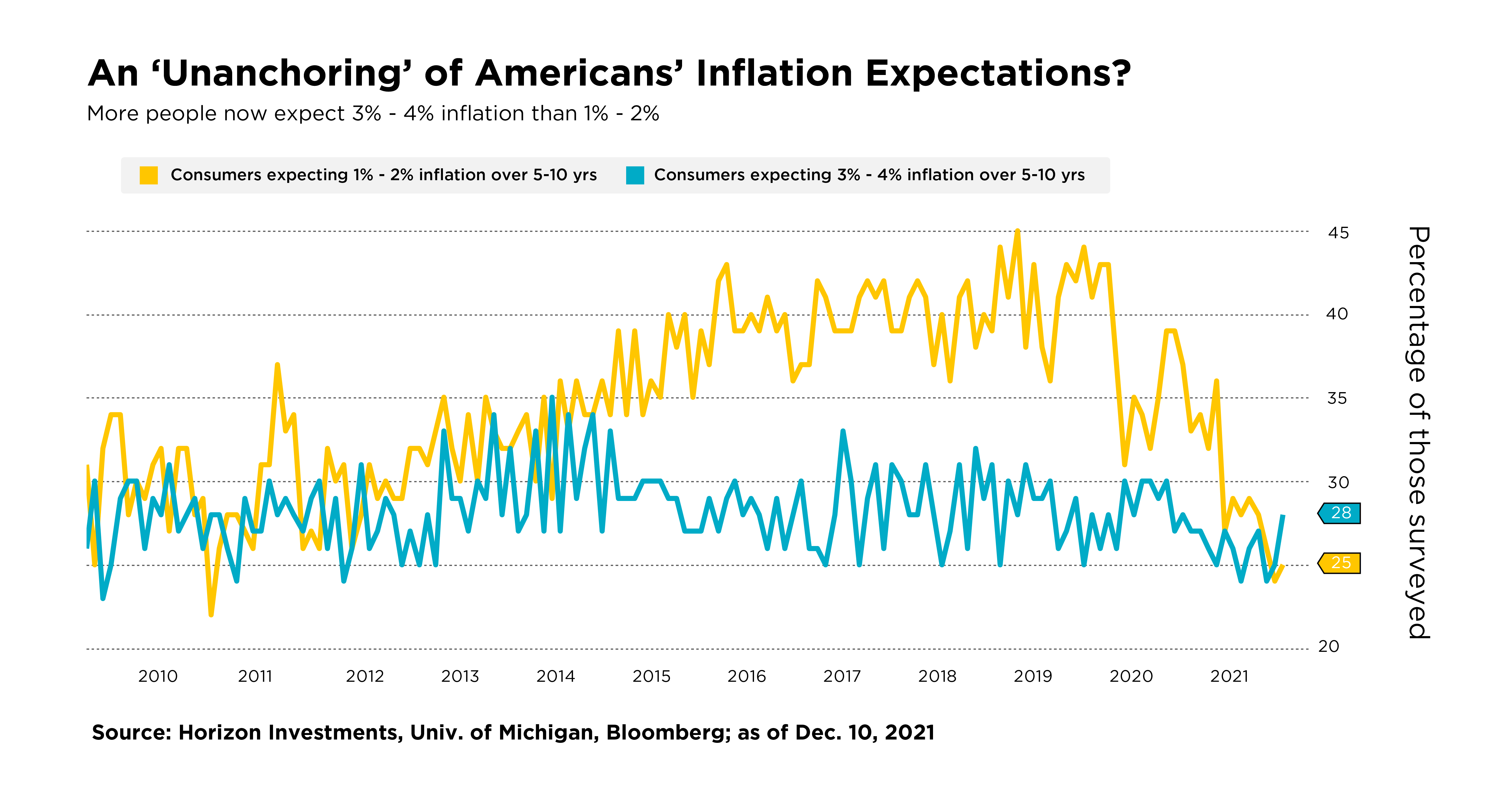The Federal Reserve’s decision this week to hurry up and end its bond-buying by the end of Q1 next year has come none too soon as rising inflation begins to be cemented in the public’s mind.[1]
A consistent concern of the Fed is that consumers’ inflation expectations could become ‘’unanchored.’’ Meaning that the roughly 2% annual inflation pace that the central bank shoots for would be rejected by Americans for a larger number. That potentially higher number would come with the risk of causing a so-called wage-price spiral. That’s when workers demand more pay to compensate for the higher cost of living, and that, in turn pushes up the cost of goods and services, which sparks further competitive rounds of pay raises and price hikes.
‘’Unanchored’’ might be developing. The University of Michigan’s most recent monthly consumer sentiment survey found that 28% of respondents see an inflation rate of 3% to 4% over the next five to 10 years. They now outnumber the 1% to 2% group, which had dominated for many years.[2]

University of Michigan survey director Richard Curtin said consumer confidence among low-income households surged this month, and was based on expectations of rising wages. That, he said, ‘’suggests an emerging wage-price spiral that could propel inflation higher in the years ahead.’’[3]
We think that has to be nipped in the bud by the Fed. Because letting it spiral out of control would likely force the Fed to aggressively raise interest rates, essentially squashing inflation by causing a recession. For the time being, we think that worst-case scenario has a low probability of happening. That’s due, in part, to the Fed’s tapering decision and its new forecast to possibly raise interest rates three times in 2022.
The Federal Reserve’s high-wire act that balances moving fast enough to quell inflation, but not so fast that a recession unfolds, isn’t guaranteed to succeed. Stocks and bond traders will probably vacillate between hope and fear for many more months as the Fed navigates these unusual circumstances.
Goals-based investors may want to consider preparing for potentially bigger swings in the value of their portfolios in 2022 as the inflation-versus-interest-rates debate plays out. While surveys such as the one from the University of Michigan suggest the macroeconomic background could be changing, it could be some time before anyone can say for certain that it is.
Investors who believe high inflation and rising interest rates pose a threat to their goals may want to think about enlisting the help of their advisor to make a list of portfolio changes they’d consider making to address those risks.
If preserving accumulated wealth has now become the primary investment goal, then Horizon Investments would say an investor is in the Protect stage of their investment journey. A strategy, such as Horizon’s Risk Assist®, may be able to help them navigate this uniquely demanding period that requires a balance between preserving wealth and continuing to grow assets to reach their financial goals.
Related Articles:
Read Our 2022 Outlook: The Next `Unprecedented Year
Inflation Sticker Shock Is Spreading to More Everyday Products
If Inflation Returns, Bond’s Diversification Power May Disappear
Essentially Nothing. That’s How Much Bonds May Return Over Next Five Years
This commentary is written by Horizon Investments’ asset management team. For additional commentary and media interviews, contact Chief Investment Officer Scott Ladner at 704-919-3602 or sladner@horizoninvestments.com.
Nothing contained herein should be construed as an offer to sell or the solicitation of an offer to buy any security. This report does not attempt to examine all the facts and circumstances that may be relevant to any company, industry or security mentioned herein. We are not soliciting any action based on this document. It is for the general information of clients of Horizon Investments, LLC (“Horizon”). This document does not constitute a personal recommendation or take into account the particular investment objectives, financial situations, or needs of individual clients. Before acting on any analysis, advice or recommendation in this document, clients should consider whether the security in question is suitable for their particular circumstances and, if necessary, seek professional advice. Investors may realize losses on any investments. Index information is intended to be indicative of broad market conditions. The performance of an unmanaged index is not indicative of the performance of any particular investment. It is not possible to invest directly in an index. The investments recommended by Horizon Investments are not guaranteed. There can be economic times where all investments are unfavorable and depreciate in value. Clients may lose money.
Past performance is not a guide to future performance. Future returns are not guaranteed, and a loss of original capital may occur. This commentary is based on public information that we consider reliable, but we do not represent that it is accurate or complete, and it should not be relied on as such. Opinions expressed herein are our opinions as of the date of this document. These opinions may not be reflected in all of our strategies. We do not intend to and will not endeavor to update the information discussed in this document. No part of this document may be (i) copied, photocopied, or duplicated in any form by any means or (ii) redistributed without Horizon’s prior written consent.
Other disclosure information is available at hinubrand.wpengine.com.
Horizon Investments, Risk Assist and the Horizon H are registered trademarks of Horizon Investments, LLC
©2021 Horizon Investments LLC
